High Magnetic Field ESR in S = 1 Skew Chain Antiferromagnet Ni2V2O7 Single Crystal
Abstract
:1. Introduction
2. Experimental Details
3. Results and Discussion
4. Conclusions
Author Contributions
Funding
Conflicts of Interest
Appendix A. Crystal Structure and Chemical Composition Analysis
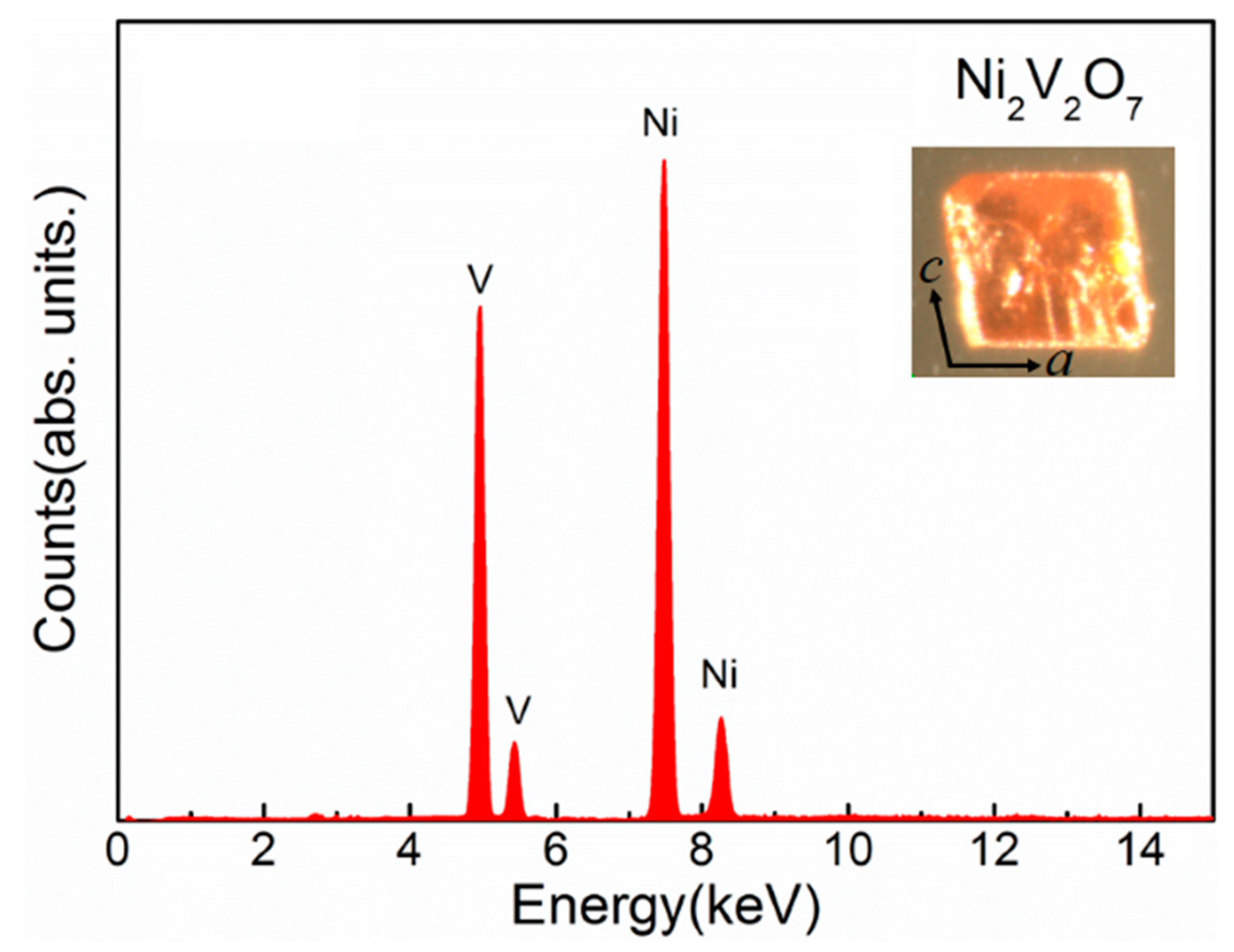
| Atom | x | y | z |
|---|---|---|---|
| Ni1 | 0.14638 | 0.12121 | 0.46311 |
| Ni2 | 0.30503 | 0.38677 | 0.67946 |
| V1 | 0.36196 | 0.73979 | 0.53114 |
| V2 | 0.19450 | 0.01873 | 0.81306 |
| O1 | 0.60227 | 0.13073 | 0.12422 |
| O2 | 0.42697 | 0.12517 | 0.39468 |
| O3 | 0.16864 | 0.36927 | 0.45918 |
| O4 | 0.25623 | 0.35937 | 0.18158 |
| O5 | 0.68036 | 0.37287 | 0.34927 |
| O6 | 0.02833 | 0.08423 | 0.24732 |
| O7 | 0.85457 | 0.37953 | 0.00762 |
Appendix B. High-Field Magnetization Curves
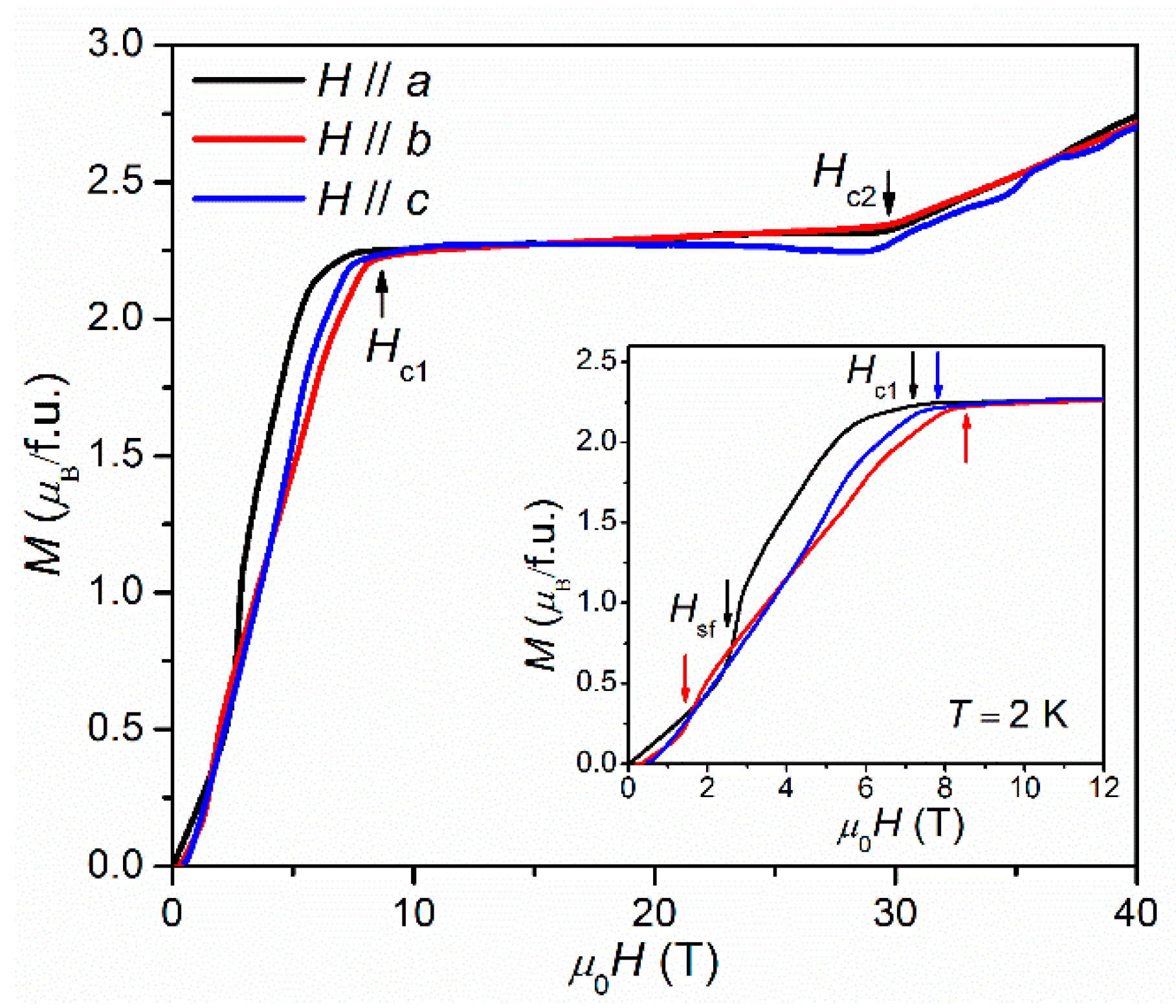
References
- Narumi, Y.; Kindo, K.; Hagiwara, M.; Nakano, H.; Kawaguchi, A.; Okunishi, K.; Kohno, M. High-field magnetization of S = 1 antiferromagnetic bond-alternating chain compounds. Phys. Rev. B 2004, 69, 174405. [Google Scholar] [CrossRef]
- Ono, T.; Tanaka, H.; Aruga Katori, H.; Ishikawa, F.; Mitamura, H.; Goto, T. Magnetization plateau in the frustrated quantum spin system Cs2CuBr4. Phys. Rev. B 2003, 67, 104431. [Google Scholar] [CrossRef]
- Choi, K.Y.; Lemmens, S.; Do, P.; van Tol, J.; Shin, J.; Jeon, G.S.; Skourski, Y.; Rhyee, J.S.; Berger, H. Coexistence of localized and collective magnetism in the coupled-spin-tetrahedra system Cu4Te5O12Cl4. Phys. Rev. B 2014, 90, 184402. [Google Scholar] [CrossRef]
- Hase, M.; Matsumoto, M.; Matsuo, A.; Kindo, K. Magnetism of the antiferromagnetic spin-1/2 tetramer compound CuInVO5. Phys. Rev. B 2016, 94, 174421. [Google Scholar] [CrossRef]
- Gitgeatpong, M.; Suewattana, S.; Zhang, A.; Miyake, M.; Tokunaga, P.; Chanlert, N.; Kurita, H.; Tanaka, T.J.; Sato, Y.; Zhao, G.; et al. High-field magnetization and magnetic phase diagram of α-Cu2V2O7. Phys. Rev. B 2017, 95, 245119. [Google Scholar] [CrossRef]
- He, Z.Z.; Ueda, Y. Paramagnetic anisotropy and spin-flop transition in single crystals of the quasi-one-dimensional system β-Cu2V2O7. Phys. Rev. B 2008, 77, 052404. [Google Scholar] [CrossRef]
- Yin, L.; Ouyang, Z.W.; Wang, J.F.; Yue, X.Y.; Chen, R.; He, Z.Z.; Wang, Z.X.; Xia, Z.C.; Liu, Y. Anisotropic magnetization plateaus in Seff = 1/2 skew-chain single-crystal Co2V2O7. Phys. Rev. B 2019, 99, 134434. [Google Scholar] [CrossRef]
- Wang, L.; Werner, J.; Ottmann, A.; Weis, R.; Abdel-Hafiez, M.; Sannigrahi, J.; Majumdar, S.; Koo, C.; Klingeler, R. Magnetoelastic coupling and ferromagnetic-type in-gap spin excitations in multiferroic α-Cu2V2O7. New J. Phys. 2018, 20, 063045. [Google Scholar] [CrossRef]
- Zhang, J.T.; Wang, J.L.; Ji, C.; Guo, B.X.; Xia, W.S.; Lu, X.M.; Zhu, J.S. Magnetism and spin-driven ferroelectricity in the multiferroic material α-Cu2V2O7. Phys. Rev. B 2017, 96, 165132. [Google Scholar] [CrossRef]
- Ponomarenkoa, L.A.; Vasil’eva, A.N.; Antipovb, E.V.; Velikodnyb, Y.A. Magnetic properties of Cu2V2O7. Phys. B 2000, 1459, 284–288. [Google Scholar] [CrossRef]
- Pommer, J.; Kataev, V.; Choi, K.-Y.; Lemmens, P.; Ionescu, A.; Pashkevich, Y.; Freimuth, A.; Güntherodt, G. Interplay between structure and magnetism in the spin-chain compound (Cu,Zn)2V2O7. Phys. Rev. B 2003, 67, 214410. [Google Scholar] [CrossRef]
- Touaiher, M.; Rissouli, K.; Benkhouja, K.; Taibi, M.; Aride, J.; Boukhari, A.; Heulin, B. Crystal structures and magnetic properties of M2V2O7 (M = Co, Ni and Cu) compounds. Mater. Chem. Phys. 2004, 85, 41–46. [Google Scholar] [CrossRef]
- Parada, C.; Perles, J.; Sáez-Puche, R.; Ruiz-Valero, C.; Snejko, N. Crystal growth, structure, and magnetic properties of a new polymorph of Fe2P2O7. Chem. Mater. 2003, 15, 3347–3351. [Google Scholar] [CrossRef]
- Dojčilović, J.; Novaković, L.; Napijalo, M.M.; Napijalo, M.L. Structural phase transitions in Co (II) and Ni (II) diphosphates in the temperature range 290–1000 K. Mater. Chem. Phys. 1994, 39, 76–79. [Google Scholar] [CrossRef]
- Weil, M.; Lengauer, C.; Füglein, E.; Baran, E.J. The reversible α→β phase transition of Cu2As2O7. Cryst. Growth Des. 2004, 4, 1229–1235. [Google Scholar] [CrossRef]
- Liao, J.H.; Leroux, F.; Piffard, Y.; Guyomard, D.; Payen, C. Synthesis, structures, magnetic properties, and phase transition of manganese (II) divanadate: Mn2V2O7. J. Solid State Chem. 1996, 121, 214–224. [Google Scholar] [CrossRef]
- Sauerbrei, E.E.; Faggiani, F.; Calvo, C. Cobalt Vanadate, Co2V2O7, and Nickel Vanadate, Ni2V2O7. Acta Crystallogr. Sect. B 1974, 30, 2907–2909. [Google Scholar] [CrossRef]
- He, Z.; Yamaura, J.I.; Ueda, Y.; Cheng, W.D. Crystal growth and multiple magnetic transitions of the spin-1 chain system Ni2V2O7. Phys. Rev. B 2009, 79, 092404. [Google Scholar] [CrossRef]
- Sun, Y.C.; Ouyang, Z.W.; Wang, J.F.; Wang, Z.X.; Xia, Z.C.; Rao, G.H. Breaking of 1D magnetism in a spin-1 chain antiferromagnet Ni2V2O7: ESR and first-principles studies. Eur. Phys. J. Plus 2016, 131, 343. [Google Scholar] [CrossRef]
- Ouyang, Z.W.; Sun, Y.C.; Wang, J.F.; Yue, X.Y.; Chen, R.; Wang, Z.X.; He, Z.Z.; Xia, Z.C.; Liu, Y.; Rao, G.H. Novel half-magnetization plateau and nematiclike transition in the S = 1 skew chain Ni2V2O7. Phys. Rev. B 2018, 97, 144406. [Google Scholar] [CrossRef]
- Chen, R.; Wang, J.F.; Ouyang, Z.W.; He, Z.Z.; Wang, S.M.; Lin, L.; Liu, J.M.; Lu, C.L.; Liu, Y.; Dong, C.; et al. Magnetic field induced ferroelectricity and half magnetization plateau in polycrystalline R2V2O7 (R = Ni, Co). Phys. Rev. B 2018, 98, 184404. [Google Scholar] [CrossRef]
- Arango, Y.C.; Vavilova, E.; Abdel-Hafiez, M.; Janson, O.; Tsirlin, A.A.; Rosner, H.; Drechsler, S.-L.; Weil, M.; Nénert, G.; Klingeler, R.; et al. Magnetic properties of the low-dimensional spin-1/2 magnet α-Cu2As2O7. Phys. Rev. B 2011, 84, 134430. [Google Scholar] [CrossRef]
- Susuki, T.; Kurita, N.; Tanaka, T.; Nojiri, H.; Matsuo, A.; Kindo, K.; Tanaka, H. Magnetization Process and Collective Excitations in the S = 1/2 Triangular-Lattice Heisenberg Antiferromagnet Ba3CoSb2O9. Phys. Rev. Lett. 2013, 110, 267201. [Google Scholar] [CrossRef] [PubMed]
- Glazkov, V.N.; Smirnov, A.I.; Revcolevschi, A.; Dhalenne, G. Magnetic resonance study of the spin-reorientation transitions in the quasi-one-dimensional antiferromagnet BaCu2Si2O7. Phys. Rev. B 2005, 72, 104401. [Google Scholar] [CrossRef]
- Kimura, S.; Ohta, H.; Mitsudo, S.; Motokawa, M.; Jang, W.J.; Hasegawa, M.; Takei, H. Submillimetre-wave electron spin-resonance measurements for single-crystal Y2Cu2O5. J. Phys. Condens. Matter 1996, 8, 546. [Google Scholar] [CrossRef]
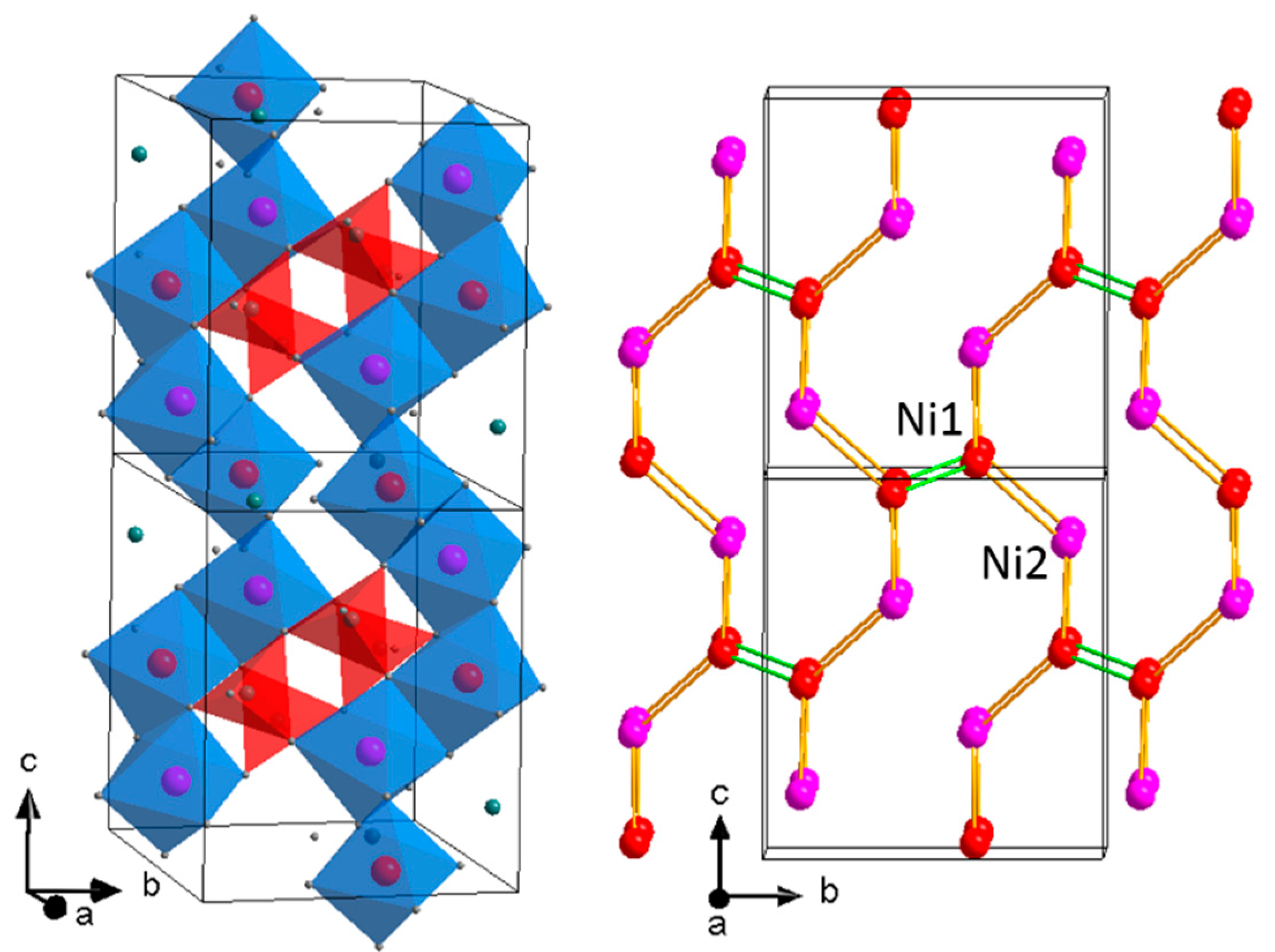
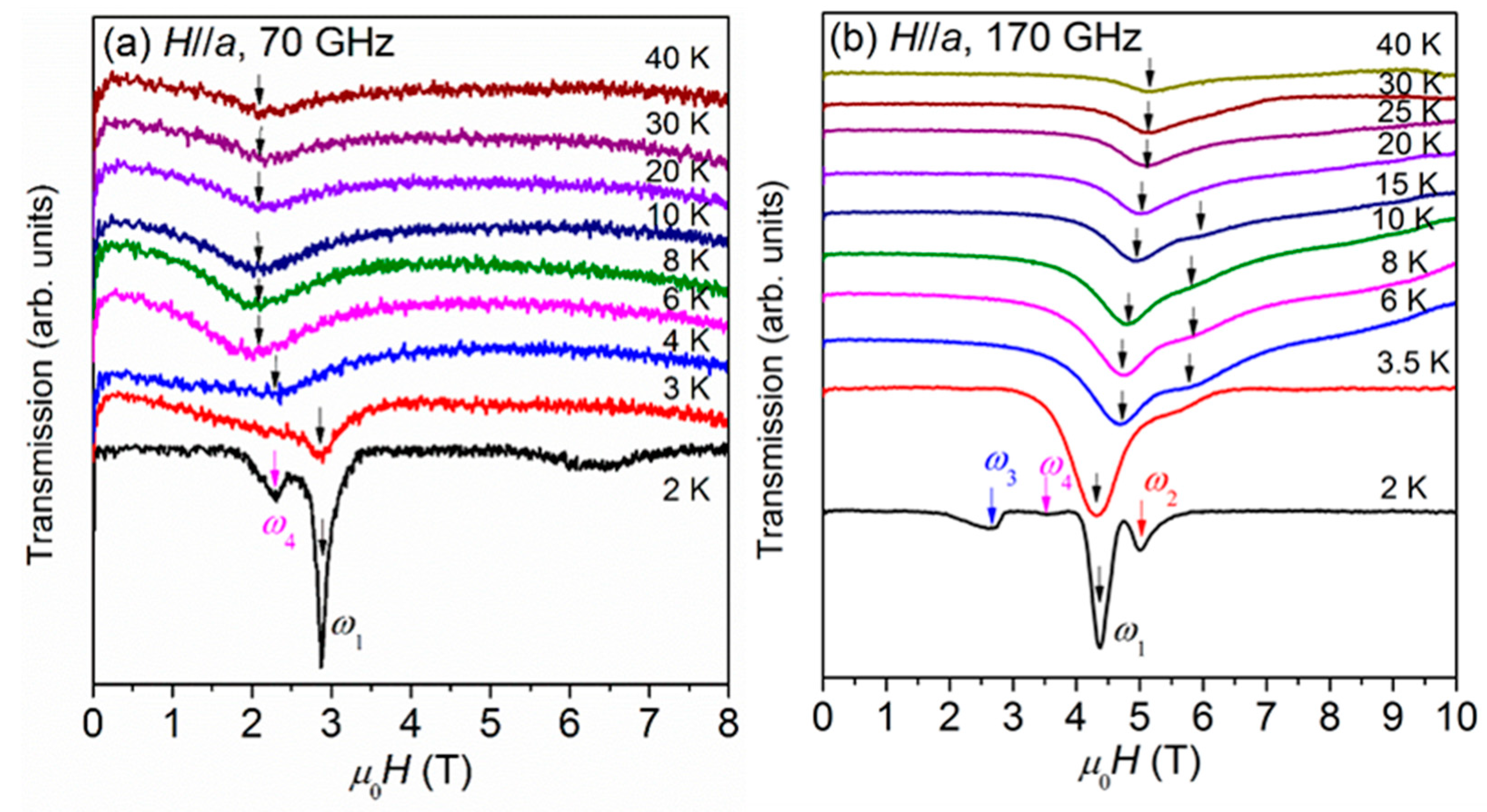
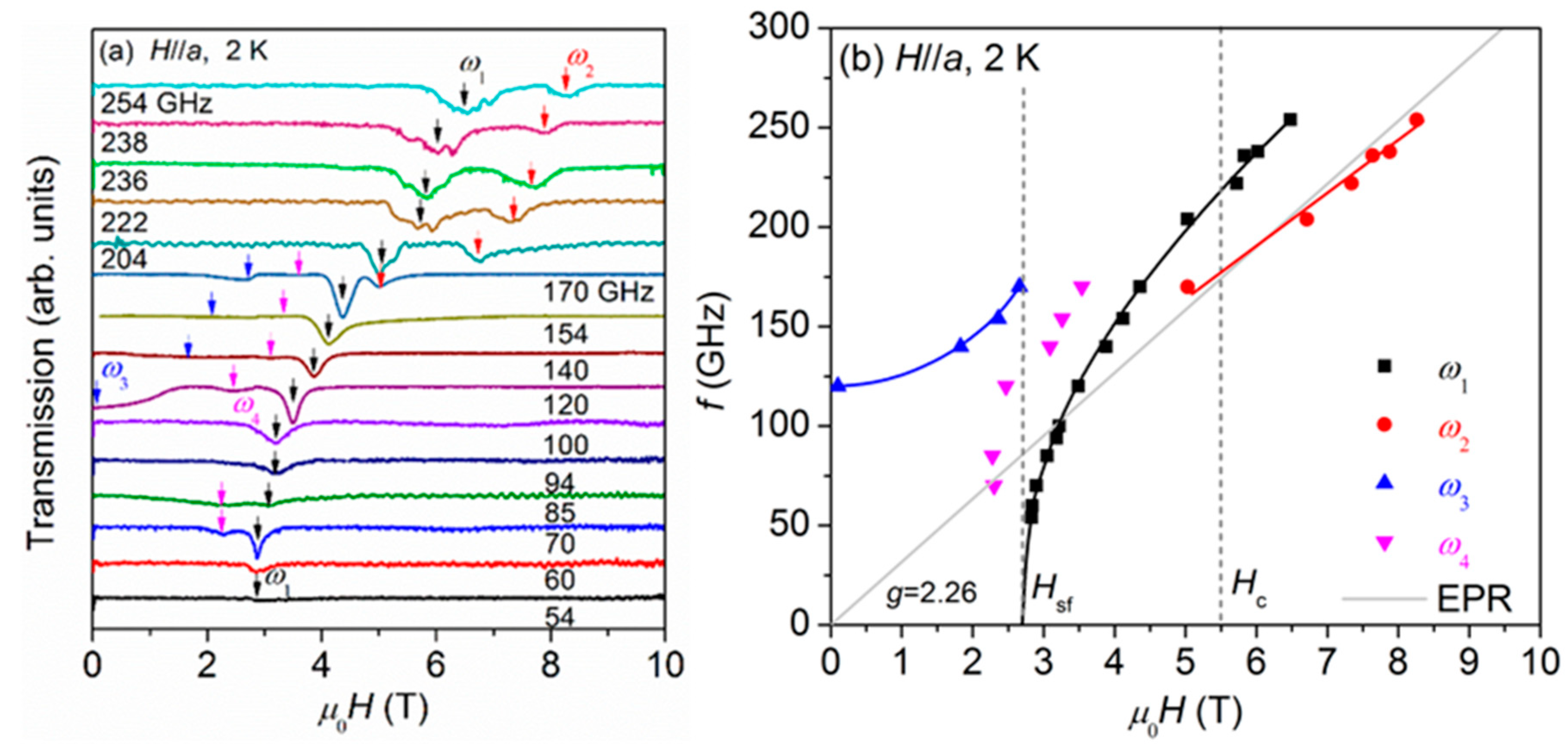
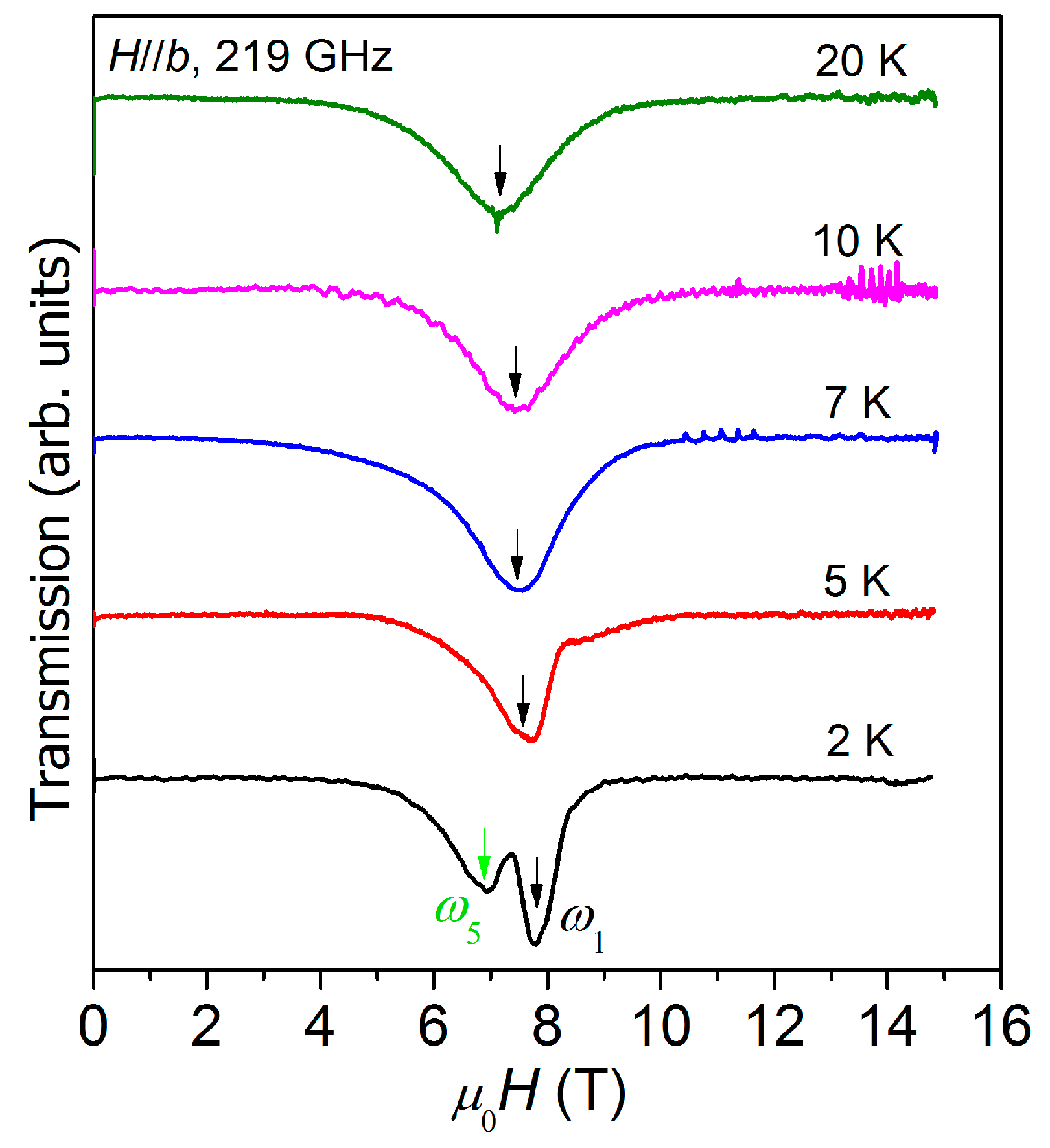
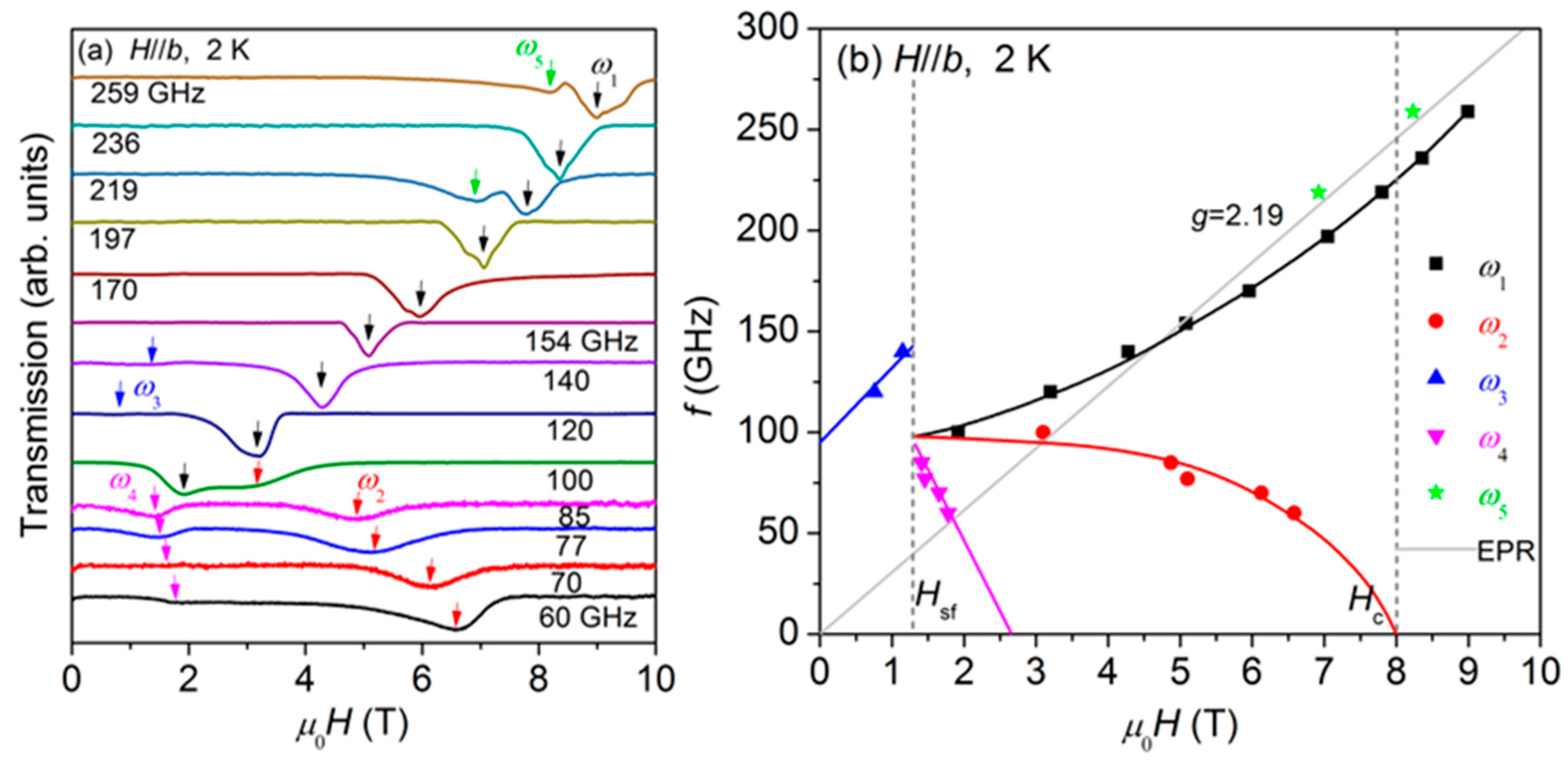
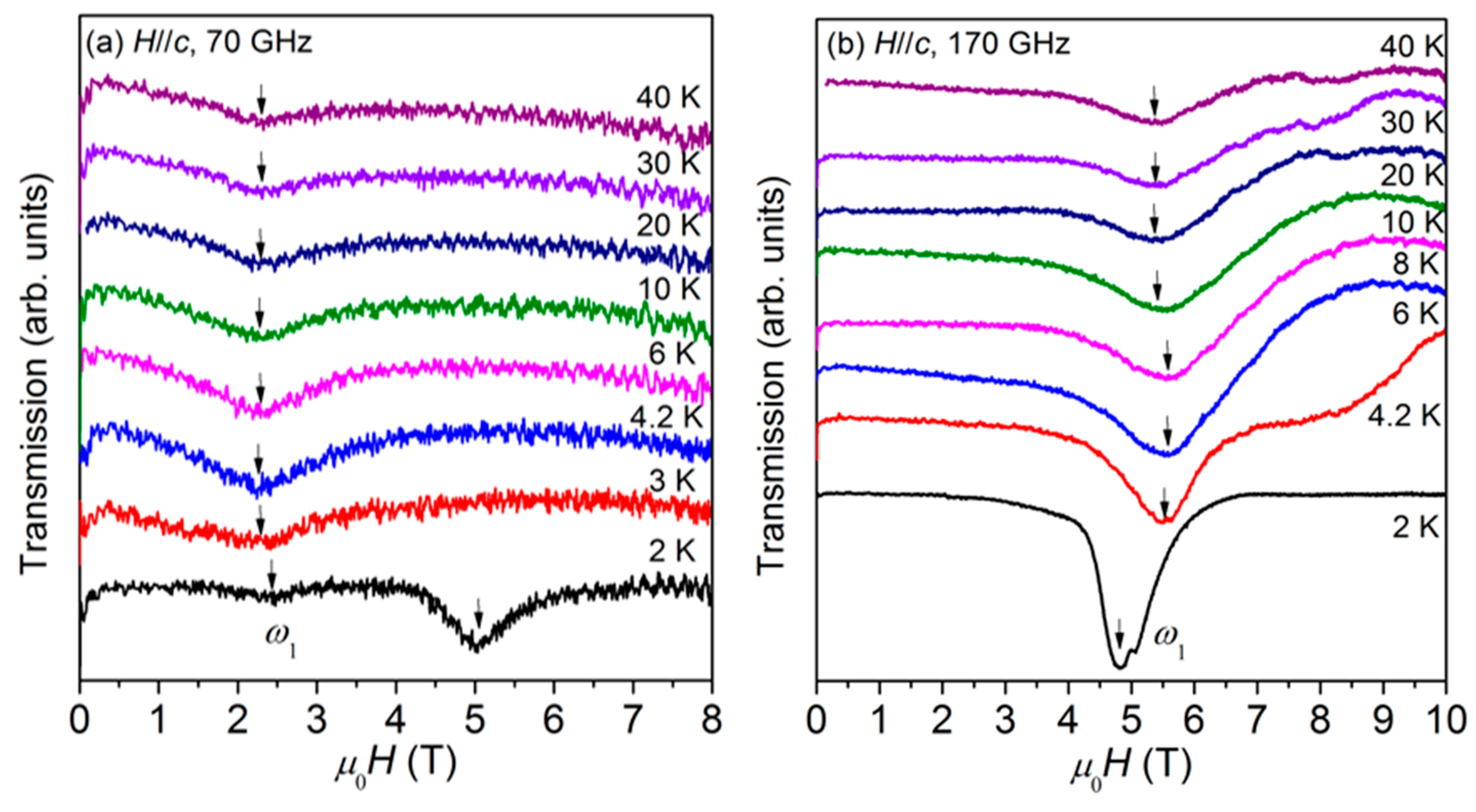
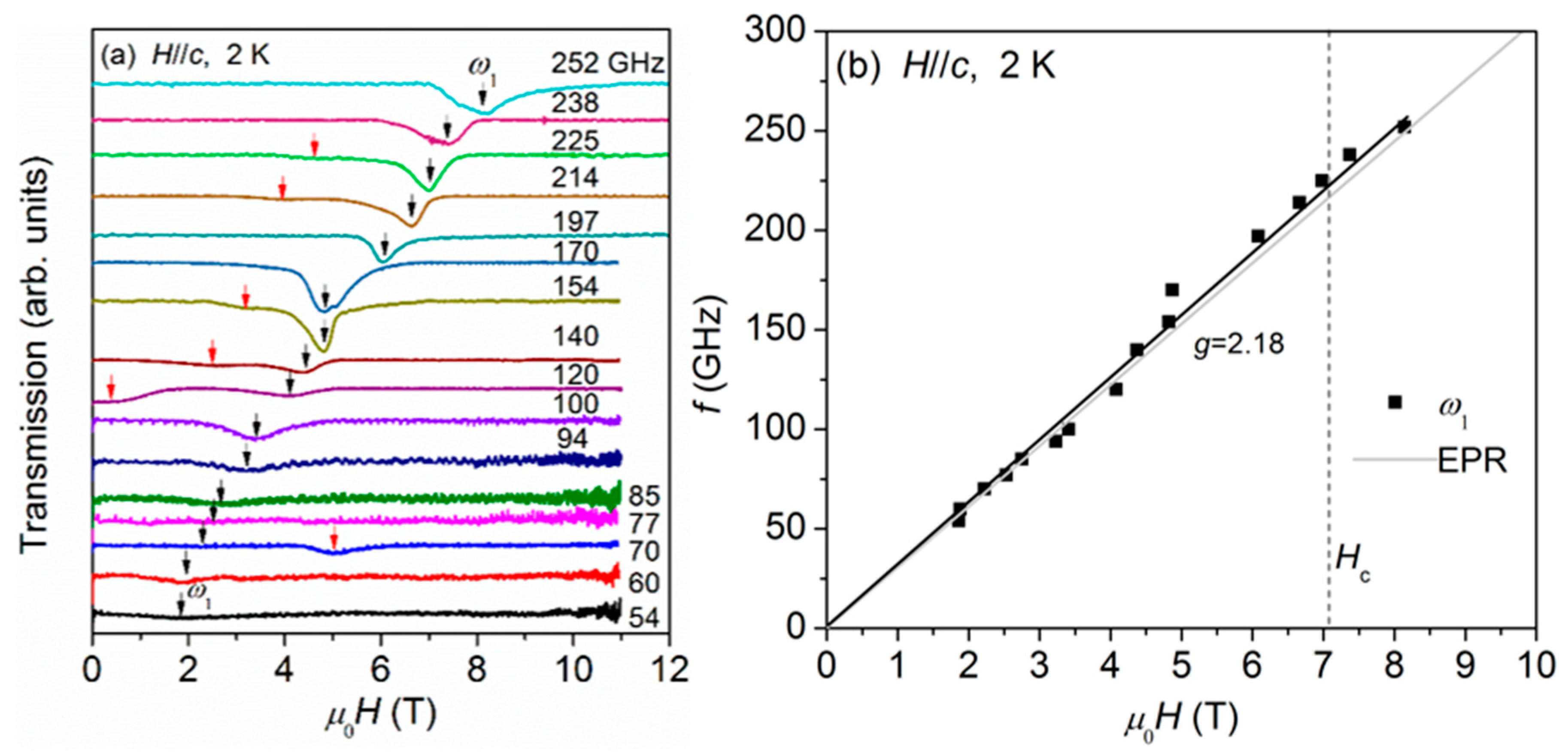
© 2019 by the authors. Licensee MDPI, Basel, Switzerland. This article is an open access article distributed under the terms and conditions of the Creative Commons Attribution (CC BY) license (http://creativecommons.org/licenses/by/4.0/).
Share and Cite
Yin, L.; Ouyang, Z.; Yue, X.; Wang, Z.; Xia, Z. High Magnetic Field ESR in S = 1 Skew Chain Antiferromagnet Ni2V2O7 Single Crystal. Crystals 2019, 9, 468. https://doi.org/10.3390/cryst9090468
Yin L, Ouyang Z, Yue X, Wang Z, Xia Z. High Magnetic Field ESR in S = 1 Skew Chain Antiferromagnet Ni2V2O7 Single Crystal. Crystals. 2019; 9(9):468. https://doi.org/10.3390/cryst9090468
Chicago/Turabian StyleYin, Lei, Zhongwen Ouyang, Xiaoyu Yue, Zhenxing Wang, and Zhengcai Xia. 2019. "High Magnetic Field ESR in S = 1 Skew Chain Antiferromagnet Ni2V2O7 Single Crystal" Crystals 9, no. 9: 468. https://doi.org/10.3390/cryst9090468
APA StyleYin, L., Ouyang, Z., Yue, X., Wang, Z., & Xia, Z. (2019). High Magnetic Field ESR in S = 1 Skew Chain Antiferromagnet Ni2V2O7 Single Crystal. Crystals, 9(9), 468. https://doi.org/10.3390/cryst9090468





